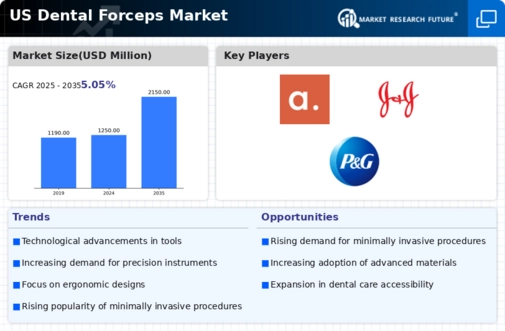Aging Population
The aging population in the US significantly influences the dental forceps market. As individuals age, they often experience dental issues that necessitate extractions, leading to an increased demand for dental forceps. The US Census Bureau projects that by 2030, nearly 20% of the population will be 65 years or older. This demographic shift suggests a potential rise in dental procedures, particularly extractions, as older adults typically require more dental interventions. Consequently, the dental forceps market is poised to expand, as dental professionals prepare to meet the needs of this growing segment. Additionally, advancements in geriatric dentistry may further drive the demand for specialized forceps designed for older patients, enhancing the overall market landscape.
Rising Dental Procedures
The increasing frequency of dental procedures in the US is a primary driver for the dental forceps market. As more individuals seek dental care, the demand for effective extraction tools rises. According to recent data, dental visits have surged, with approximately 65% of adults visiting a dentist annually. This trend indicates a growing need for dental forceps, as practitioners require reliable instruments to perform extractions efficiently. The dental forceps market is likely to benefit from this rise in dental procedures, as practitioners invest in high-quality tools to enhance patient care and outcomes. Furthermore, the expansion of dental practices and the introduction of new extraction techniques may further stimulate demand for specialized forceps, thereby contributing to market growth.
Technological Innovations
Technological innovations in dental instruments are reshaping the dental forceps market. The introduction of advanced materials and designs enhances the functionality and effectiveness of forceps, making them more appealing to dental practitioners. For instance, the use of lightweight, durable materials can improve maneuverability and reduce fatigue during procedures. Furthermore, innovations such as ergonomic designs and improved grip features are likely to enhance user experience. As dental professionals increasingly seek tools that offer precision and comfort, the dental forceps market is expected to witness growth driven by these technological advancements. The integration of digital technologies, such as 3D printing for custom forceps, may also emerge as a trend, potentially revolutionizing the market.
Expansion of Dental Practices
The expansion of dental practices across the US is a crucial factor influencing the dental forceps market. As new dental clinics open and existing practices expand their services, the demand for dental instruments, including forceps, is likely to increase. This trend is supported by the rise of group practices and dental service organizations, which often require standardized tools for efficiency. Additionally, the competitive landscape encourages dental professionals to invest in high-quality instruments to attract and retain patients. The dental forceps market is expected to thrive as practices seek to enhance their operational capabilities and improve patient outcomes. Furthermore, the trend towards specialization in dentistry may lead to a greater demand for specific types of forceps, further diversifying the market.
Increased Awareness of Oral Health
The growing awareness of oral health among the US population is a significant driver for the dental forceps market. Public health campaigns and educational initiatives have emphasized the importance of regular dental check-ups and proper oral hygiene. As individuals become more conscious of their dental health, the demand for dental services, including extractions, is likely to rise. This trend is reflected in the increasing number of dental insurance plans that cover extraction procedures, making them more accessible to a broader audience. Consequently, the dental forceps market stands to benefit from this heightened awareness, as dental practitioners require reliable and effective tools to meet the needs of their patients. The emphasis on preventive care may also lead to an increase in routine extractions, further driving market growth.














Leave a Comment